
From Jazz to Jungle: Urban Kayaking in New Orleans' Bayou Metairie
Explore New Orleans beyond its jazz clubs through the tranquil, winding waters of Bayou Metairie. Urban kayaking here offers a fresh perspective on the city’s natural side, blending quiet wildlife observation with a taste of adventure under the urban canopy.
Choose the Right Kayak
Opt for a sturdy, shallow-draft kayak that can handle narrow, sometimes obstructed waterways and occasional shallow stretches.
Lightweight, Quick-Dry Gear
Wear quick-drying clothes and shoes to stay comfortable when you inevitably get wet or need to pull your kayak over obstacles.
Hydrate Early and Often
Bring at least two liters of water per person. The southern sun can be deceptive, especially in the late morning or early afternoon.
Respect Local Wildlife
Keep distance from animals and avoid disturbing nesting sites to preserve the bayou’s delicate ecosystem.
From Jazz to Jungle: Urban Kayaking in New Orleans' Bayou Metairie
New Orleans is a city known for its vibrant jazz rhythms and rich culture, yet a quieter, greener side waits beneath the canopy along Bayou Metairie. This waterway, threading through the city's northern edges, challenges urban explorers to trade the honky-tonks for kayaks and discover a hidden world where swamp meets city.
Starting your journey at the Bayou Metairie Trailhead, you’ll find calm waters that dare you forward, weaving beneath live oaks dripping with Spanish moss. The bayou is fiercely itself – a mix of sluggish current and sudden narrow passages demanding careful navigation. As you paddle, the city's hum fades behind, replaced by the splash of oars and the occasional call of a heron or turtle sunning on a fallen branch.
The full route covers roughly 3 miles of paddling, mostly flat water with intermittent shallow spots requiring measured strokes and occasional dismounting to pull or carry your kayak around snagged areas. The terrain along the banks shifts between thick groves of cypress, and urban vegetation, framed by graffiti-streaked concrete remnants – a reminder you’re still within city limits.
Timing your trip early in the morning or late afternoon helps avoid midday heat and brings soft, golden light that dances on the water’s surface. Hydration is vital; bring plenty of fresh water and a hat to shield your face. Footwear should be sturdy yet quick-draining—think water shoes or lightweight hiking sandals—for those moments when you step ashore to explore or maneuver your kayak.
Paddling Bayou Metairie isn’t just a chance to witness wildlife like turtles, raccoons, and a variety of wading birds; it’s a conversation with a waterway that’s been part of New Orleans’ lifeblood for centuries. The bayou challenges and welcomes you in equal measure: respect its twists, prepare for the unexpected, and you’ll find yourself immersed in a unique blend of city and wilderness.
For many, the route culminates in a viewpoint overlooking the sprawling Audubon Park, where the urban jungle and nature’s wild side meet in a quiet handshake. It’s a practical adventure, rich with discovery, perfect for paddlers curious to see the city from a different angle—where the vibrant jazz fades and the bayou’s whispered stories take center stage.
Nearby Trips
All Adventures
Boat Charters
Water Activities
Adventures near New Orleans, Louisiana
Discover the unique and memorable adventures that make New Orleans, Louisiana special.
Frequently Asked Questions
Is kayaking Bayou Metairie suitable for beginners?
Bayou Metairie offers a moderate challenge with calm stretches interspersed with narrow, obstacle-lined sections. Beginners with some kayaking experience should be comfortable, but new paddlers may want to practice basic skills beforehand.
Are there kayak rentals available nearby?
Yes, several outfitters in the New Orleans area offer kayak rentals with drop-off points near Bayou Metairie. Booking in advance is recommended, especially on weekends and holidays.
What wildlife might I see along the bayou?
Expect to encounter wading birds like herons and egrets, turtles basking on logs, and sometimes raccoons near the banks. Early morning and dusk offer the best wildlife viewing opportunities.
Is it safe to kayak alone on Bayou Metairie?
While generally safe, kayaking alone obliges extra precautions due to occasional obstacles and urban proximity. Inform someone of your plans, carry a phone in waterproof protection, and be mindful of tide and weather conditions.
Are there guided tours available?
Several local adventure companies offer guided kayaking tours that combine expert navigation with insights into the bayou’s ecology and history, ideal for first-timers or those wanting a deeper experience.
How do tides and weather affect the kayaking experience?
Bayou Metairie’s water levels can vary with rainfall and tides, influencing navigation; low water means more obstacles but less current, while high water fills the bayou making for smoother paddling. Check local weather forecasts and water conditions before your trip.
Recommended Gear
Sit-on-Top Kayak
Provides stability and easy exit for navigating shallow, obstacle-filled bayou waters.
Quick-Dry Clothing
Keeps you comfortable through wettings and variable weather typical of Louisiana summers.
Wide-Brimmed Hat
Protects your face and neck from sun exposure during long daylight hours on open sections.
Insect Repellent
Crucial for keeping mosquitoes and biting insects at bay, especially during warmer months.
Local Insights
Hidden Gems
- "A quiet cove near Elysian Fields Avenue where otters occasionally emerge"
- "Graffiti murals on concrete remnants, tracing New Orleans’ urban evolution"
Wildlife
- "Great blue herons hunting at dawn"
- "River otters playing near secluded bends"
- "Turtles sunning on fallen branches"
History
"Bayou Metairie has historically served as a natural drainage channel for New Orleans, shaping settlement patterns and connecting communities long before modern infrastructure reshaped the landscape."